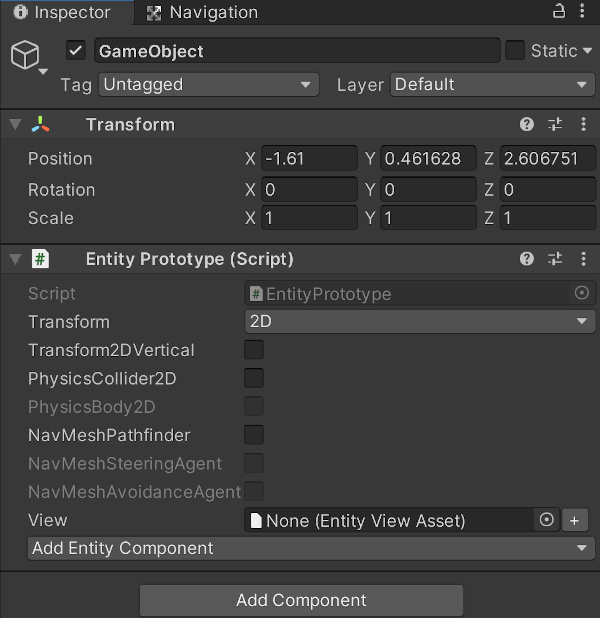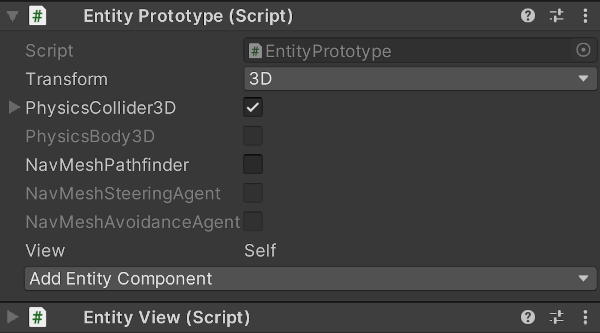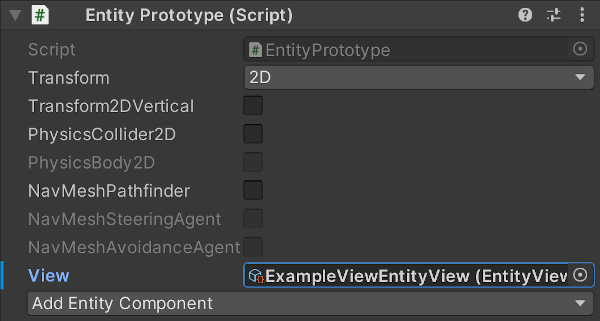Entity Prototypes
Introduction
To facilitate data driven design, Quantum 2.0 introduced Entity Prototypes.
An Entity Prototype is a serialized version of an entity that includes:
- composition (i.e. which components it is made of); and,
- data (i.e. the components' properties and their initial value).
This allows for a clean separation of data and behaviour, while enabling designers to tweak the former without programmers having to constantly edit the latter.
Setting up a Prototype
Entity prototypes can be set up in Unity Editor.
Basic
To create an Entity Prototype simply add the Entity Prototype script to any GameObject.

The Entity Prototype script allows you to set up and define the parameters for the most commonly used components for both 2D and 3D.
- Transform (including Transform2DVertical for 2D)
- PhysicsCollider
- PhysicsBody
- NavMeshPathFinder
- NavMeshSteeringAgent
- NavMeshAvoidanceAgent
The dependencies for the Physics and NavMesh related agents are respected.
For more information, please read their respective documentation.
Custom Components
Additional components can be added to an Entity Prototype via either:
- the Add Entity Component drop-down; or,
- the regular Unity Add Component button by searching for the right Entity Component.
Note on Collections
Dynamic collections in components are only automatically allocated IF there is at least one item in them. Otherwise, the collection will have to be allocated manually. For more information on the subject, refer to the Dynamics Collection entry on the DSL page.
Hierarchy
In ECS the concept of entity/GameObject hierarchy does not exist. As such entity prototypes do not support hierarchies or nesting.
Although child prototypes are not supported directly, you can:
- Create separate prototypes in the scene and bake them.
- Link them by keeping a reference in a component.
- Update the position of the "child" manually.
Note: Prototypes that are not baked in scene will have to follow a different workflow where the entities are created and linked in code.
You can have hierarchies in objects (View), however hierarchies in entities (Simulation) will have to be handled by you.
Creating/Instantiating a Prototype
Once a Entity Prototype has been defined in Unity, there are various ways to include it in the simulation.
Baked in the Scene/Map
If the Entity Prototype is created as part of a Unity Scene, it will be baked into the corresponding Map Asset. The baked Entity Prototype will be loaded when the Map is and initialized with the values it was baked with.
N.B.: If a Scene's Entity Prototype is edited or has its values changed, the Map Data has to be re-baked.
In Code
To create a new entity from an Entity Prototype, you need to follow these steps:
- Create a Unity Prefab of the GameObject carrying the EntityPrototype script.
- Place the Prefab in
Resources\DB.

- Refresh the Quantum Database
Quantum -> Generate Asset Resources. - Make the Entity Prototy Asset Path or GUID available to your simulation.

- Call
Create()via the frame and pass, for example, the EntityPrototype reference, or an instance of it:
C#
void CreateExampleEntity(Frame f){
// using a reference
var exampleEntity = f.Create(myPrototypeReference);
// OR, getting an instance before, using the asset's path as a parameter, and then creating the entity
var entityPrototype = f.FindAsset<EntityPrototype>("Resources/DB/Prefabs/Example|EntityPrototype");
var exampleEntity = f.Create(entityPrototype);
}
Note
Entity Prototypes present in the Scene are baked into the Map Asset, while prefabed Entity Prototypes are individual Assets that are part of the Quantum Asset DataBase.
Entity View
The Entity View corresponds to the visual representation of an entity in Unity.
In the spirit of data driven design, an Entity Prototype can either incorporate its View component or point to a separate EntityView Asset.
Self
To set an Entity Prototype's view to itself, simply add the Entity View component to it.


Separate from Prototype
To set up and link a view separate from the Entity Prototype asset:
- Add the Entity View to the GameObject you would like to represent the view.
- Prefab the GameObject carrying the Entity View.
- Place the prefab in
Resources\DB, this will create an Entity View Asset nested in the prefab.

- Refresh the database
Quantum -> Generate Asset Resources. - Link the View field from the Entity Prototype with the newly created Entity View Asset. This can be done via drag-and-drop or the Unity context search menu.

Important
For an Entity View to be visible in Unity, the scene has to have an EntityViewUpdater script.